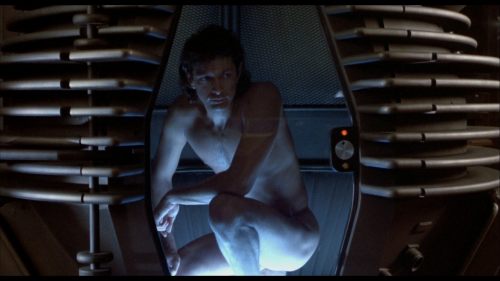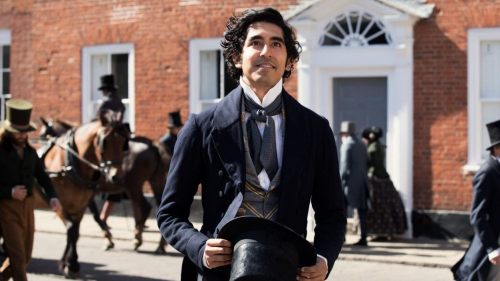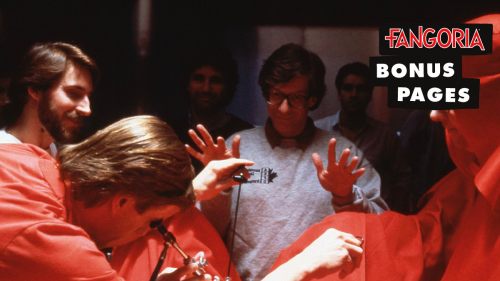Greetings From Interzone
Impromptu travel: If I believed in a soul, I’d tell you it’s good for that soul. Being able to occasionally make a hard right turn on your calendar, pick up with little to no warning and hit the road to do something spontaneous makes you feel energized and alive. Throwing two days worth of clean clothes into a bag and darting out the door. Saying “yes” to a cheap flight to Buffalo and then a drive across the border into Canada. It feels like freedom.
And while it feels like freedom, let’s be clear that it’s the opposite. Because an addict is not free. And like any other addict, I’m a slave to my obsessions and my compulsions. I’m often battling them, with good days and bad, but sometimes I stop resisting and let them consume me. Because it’s fun. Because I’m weak. Because I’m an addict. And so it was that I found myself standing on a Toronto street embarking on what was to me a special, if partly involuntary, pilgrimage.
I’d done movie road trips before. I’ve posed at the bottom of the Exorcist steps in Georgetown. I’ve eaten a steak in the dining room of Leatherface’s house from 1974’s The Texas Chain Saw Massacre. I’ve wandered the Monroeville Mall from 1978’s Dawn Of The Dead. Twice. But those field trips were always connected to some larger, more-or-less real world reason for being in those areas. But last weekend I was standing on King Street in Toronto specifically to spend some time in David Cronenberg’s world. In November TIFF opened an exhibit/film series called David Cronenberg: Evolution, and they went all out: a vast display of props, sets, costumes and other artifacts from the director’s 45-year career. To Torontonians, the exhibit seems like a fun, respectful attraction celebrating the city’s favorite cinematic son; to an afflicted film nerd, it’s serious business.
In the lobby of the TIFF Bell Lightbox, you’re greeted by a massive lenticular portrait of Cronenberg:
Beyond this wall, the exhibit begins. It’s arranged in chronological order, like my DVD collection. This pleases me. A remarkably well-preserved costume from 1969’s Stereo stands guard over a large, rotting latex "Hobbes’ Parasite" from 1975’s Shivers. It’s immediately remarkable how much ephemera was saved from Cronenberg’s early years; a treatment called Telepathy 2000 gives way to an outline for The Sensitives, which eventually becomes 1980's Scanners. Curated and arranged as they are, you’re invited to witness the creative evolution of handwritten treatments from the '70s like Roger Pagan, Gynecologist (the dialogue on that one is a howler) into more familiar titles like Dead Ringers.
TIFF has grouped Cronenberg’s career into three phases: “Who Is My Creator?” covering his early first films up to Scanners; “Who Am I?” covering 1983’s Videodrome to 1999’s eXistenZ; and “Who Are We?”, grouping everything from 2002's Spider to 2012's Cosmopolis with a thesis that presents a compelling case for what many have termed a less iconic period for the director. The exhibit is built in a circle, which comes in handy because there’s just too much to take in on one pass. Rosanna Arquette’s leg braces from Crash; Jude Law’s gristle gun from eXistenZ; the terrifying gynecological “Instruments For Operating On Mutant Women” from Dead Ringers. I think I lapped the exhibit three times, soaking up details. One of my favorite sights wasn’t a rare prop or makeup effect, but a test audience response card from a screening of 1983's Videodrome. In the paragraph-sized, lined space provided to give notes, one audience member wrote in large letters, “S-U-C-K-E-D.” Over the multiple choices provided to indicate how often said audience member went to the movies, the response was scrawled: “NOT ANY MORE.” I love that Cronenberg kept this (much of the exhibit was donated to TIFF by the director). It’s an important reminder that a lot of our modern classics weren’t particularly well-received upon release.
(The below two photos are from blogto.com)
Some of the director’s films are, understandably, underrepresented - Fast Company and The Dead Zone just aren’t going to have the same wealth of artifacts as the films for which Cronenberg and his team built entire worlds - but it’s nevertheless fascinating to see the care and detail art director Carol Spier put into even the more “mundane” tasks under her jurisdiction. But when you, after looking at newspaper props from The Brood and costume sketches from Scanners, round a corner and find yourself standing in front of the Brundlepod, that’s a fucking moment, friends. Someone at TIFF produced that moment, and it’s perfect.
The props from Naked Lunch are so bountiful that the film gets its own separate room, and a Splash Mountain-esque photo op:
Throughout the exhibit, video installations compete with the costumes and props for your attention. At the end of the exhibit, a small room screens three short films by Cronenberg: 2000’s bittersweet and touching “Camera”; 2007’s “At The Suicide Of The Last Jew In The World In The Last Cinema In The World” (trust me, way funnier than it sounds); and “The Nest,” which might technically be Cronenberg’s first found-footage piece.
The fourth floor of the venue housed the fictional BMC Labs, the mission of which I’ve covered previously on BAD, but suffice it to say they went the extra mile here, bumping my custom POD (and those of some of my friends) to the front of the queue so we could take them home. The Lab itself is a neat little marvel of production design, a single row of jars and a 3D printer transformed, through lights and mirrors, into an ominous, impressive-looking laboratory.
I finished my visit with a big-screen viewing of TIFF’s restored digital print of Shivers. I hadn’t seen the film in more than fifteen years, and I truly felt like I was watching it for the first time. (Cronenberg himself might suggest that since the human body completely regenerates every one of its cells every 7-10 years, the human being I am right now was indeed watching Shivers for the very first time. Anyway.) I’d either forgotten or never realized how intentionally hilarious the film is and, though it’s 39 years old, the film’s power to make the viewer squirm is intact. That observation felt familiar, as I think I made it at least once per film while revisiting Cronenberg’s work in the week leading up to the visit.
This weekend is Evolution's final exhibit. But whether you can get to Toronto or not, you’re going to want to bookmark the virtual exhibition, which I suspect will be live after this weekend. It was available to us at the venue, and it’s pretty spectacular, providing interview clips, an interactive "then and now" exploration of film locations and, coolest of all, increased 3D access to the props and documents that were viewable solely under glass in person. The exhibit is also showcased (along with a captivating new interview with Cronenberg) in a massive hardcover book, well worth the $40 price tag.
That night, I teased my host about the VHS collection that he was still watching on his HD television. We debated the merits of upgrading certain films or shows to a high-definition format, and the closest I came to a strong argument was this: for some titles - the original Star Trek, The Twilight Zone - seeing them in high-def is almost a new way to experience something with which we thought we were infinitely familiar. And more importantly, it’s a “pure” way to do that - you’re not post-converting it to 3D, or remixing its soundtrack to 7.1, or colorizing it. You’re going back to the original, not altering it in any manner, and coming up with a way to see this thing you love as if it’s for the first time. I realized later that’s pretty much what I was doing at TIFF’s Cronenberg exhibit. I think I’m always looking for a new way to experience my favorite things, rather than repeat them over and over. And maybe getting on a plane and spending a weekend picking over the props and costumes and production paperwork of these films wasn’t the most productive use of my time, but it certainly caused me to re-engage with the material in a way I hadn’t in years, maybe ever.
TIFF is doing a similar exhibit on Stanley Kubrick this fall. Road trip, anyone?



